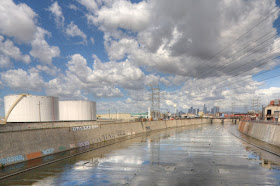 |
| The L.A. River through Downtown Los Angeles en.wikipedi.org |
Frustration reigns supreme today in the blogosphere. The WiFi gremlins seem to be getting the better of yours truly. Nevertheless, your intrepid blogger will ford ahead with today's follow up post on architect Frank Gehry's plans to revitalize the Los Angeles River. On August 18, 2015, yours truly reported that Mr. Gehry had been quietly working, at the behest of the non-profit L.A. River Corporation, on a master plan the L.A. River. Concerns were expressed over the secrecy of the project-no hint of the scope or even a napkin sketch was available. Now, Christopher Hawthorne in his article for the Los Angeles Times, "Frank Gehry agreed to make over the L.A. River-with one big condition," offers some background about the architect's involvement, why it just might work, and some of the questions it raises.
 |
| Frank O. Gehry renegadechicks.com |
His firm, Gehry Partners have little experience in working on master plans, including an aborted attempt at redesigning the Atlantic Yards in Brooklyn, New York for developer Bruce Ratner. The firm is, perhaps, better-
 |
| Frank Gehry model for Atlantic Yards Brooklyn, New York brooklynpaper.com |
They came to see me and said they were heading up a committee for Mayor Garcetti and said we have this wonderful river, 51 miles, and that if we could brand it, give it visual coherence, it could become something special..."
 |
| The Pond and Hallett Nature Sanctuary Central Park, New York City en.wikipedia.org |
The thought of Frank Gehry designing the master plan for the L.A. River may not be as far fetched as it may sound. Christopher Hawthorne writes, "The architect has also long been fascinated with Los Angeles as a city defined by huge, linear, public-works projects. In that sense the river is a relative, an overlooked cousin, of Wilshire Boulevard (which Gehry has frequently called the city's true downtown) and L.A.'s freeways." Mr. Gehry has been assembling a team of engineers and designers for meetings in his Santa Monica office. The team members include Richard Roark, a partner in the Philadelphia-based landscape architecture firm Olin and water-management expert Henk Ovink and consultants from Geosyntec engineering firm. Two of Gehry Partners's younger partners, Tensho Takemori and Anand Devarajan represent the firm.
 |
| Los Angeles River after a storm eecue.com |
 |
| The L.A. River before the concrete caltrout.org |
The 3-D digital model, along with new high-definition photography, will give us an objective starting point for the river that everybody can work on.
The second part of the attraction equation has more to do with day-to-day City Hall politics. Mr. Gehry, who has been doing pro bono research on the river so far, has the celebrity cache and dynamic personality to bring together political support and fund raising efforts. This is particularly important because successfully pulling off this endeavor will require giving space to the dozens of cities and jurisdictions who have a say over the river. Mr. Hawthorne writes, "Garcetti has faced criticism since he was a City Council member for his preternatural caution. Here is a chance to swing for the fences."
 |
| Elysian Valley community of Frogtown Los Angeles, California eventbrite.com |
Christopher Hawthorne writes, "The irony is that the original effort to wrap the river in concrete was executed in part to please big landowners and developers, to protect their property from seasonal flooding and keep the Southern California growth machine humming." The news that the mayor is giving over the planning to Gehry Partners has already rankled longtime river advocates including Lewis McAdams, co-founder of Friends of the Los Angeles River. FOLAR's skepticism is understandable because if the Gehry-led team helps build a new consensus about the river as a civic amenity, Mayor Garcetti's risk will have been worth it. Further, if new attention on river planning results in a genuinely meaningful public conversation about water policy, drought, and climate change, so much the better.
 |
| Man walking his dog along the L.A. River latimes.com |
On at least one basic level, Frank Gehry's vision for the river will probably be a marked break from previous proposals. Realistically, there is no practical way to remove all or most of the concrete, something that previous initiatives have touted through soft-focus Arcadian drawings. In this respect, working with concrete is something Mr. Gehry is familiar. Concrete is a wonderful material with many sculptural qualities. Concrete has also produced an un-wonderful L.A. River landscape, "...which at certain points reaches a monumental scale, like a freeway without cars..." Frank Gehry told Christopher Hawthorne, I don't see tearing out the concrete...It's an architectural feature, and I can see ways of incorporating it into what we're doing.
No comments:
Post a Comment